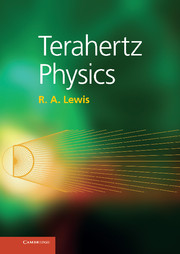9 - DETECTORS
from Part II - Components
Published online by Cambridge University Press: 05 July 2013
Summary
The mathematics used in this chapter is limited to the operations of addition, subtraction, multiplication, division and a little differentiation.
In this chapter, we look at sensors of terahertz-frequency electromagnetic radiation. Terahertz sensors detect invisible terahertz radiation and convert it to something perceptible to a human being – usually a number on a dial or on a screen.
Terahertz-frequency electromagnetic radiation is invisible. The human eye cannot see it. How can we tell it is there?
The other human senses are not much help. We cannot taste, or hear, or smell terahertz radiation. We can feel it – we perceive terahertz radiation as heat – but only if it is rather intense. The human body, on the whole, is rather insensitive to terahertz radiation.
Devices that are sensitive to terahertz radiation and convert it to a signal that humans understand are called sensors or detectors. The general term for a device that converts a signal from one form to another is a transducer. Most commonly, the transducer takes a physical property, such as temperature, acceleration or viscosity, and converts it to an electrical signal, since electrical signals are easily stored and manipulated. Of course, a terahertz-frequency electromagnetic wave is already an electrical signal, but it is at too high a frequency and often at too low an intensity for a human to sense easily. A terahertz sensor takes in the terahertz-frequency electromagnetic wave and gives out or records a reading at a lower frequency that is perceptible to you or me.
- Type
- Chapter
- Information
- Terahertz Physics , pp. 190 - 204Publisher: Cambridge University PressPrint publication year: 2013

